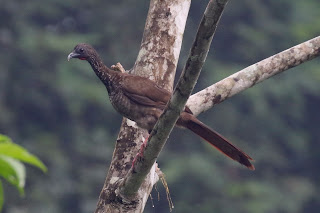Band-tailed Pigeons range from the western United States to well down into the Andes.
I had walked in less that half a mile and was becoming concerned about leaving all my stuff in the car, including my money. Plus I was not seeing much other than an invisible tanager flock so I started back to the car. On the way back I had a bird calling close to the trail. I was able to record it on my iPhone and after playback saw a little slaty gray thing zipping around the vegetation near my feet. I thought it was a tapaculo at the time and after researching on Xeno-canto, it turns out to be Blackish Tapaculo. I got this bad photo of a young tapaculo a few days later near the same spot.
This hermit confused me. It's colored like a Tawny-bellied Hermit but the proportions seem wrong. Maybe it's just molting or is a young bird.
I returned to the car and was approached by a man wanting me to sign in at the visitor's cabin. He didn't ask for a fee. He told me he had heard toucans but it was getting foggy and I could not hear or see anything from the overlook. I later found out on eBird that a pair of Turkish birders along with their guide had seen 44 species on the same trail that morning. Hiring a guide with recordings definitely helps you see more stuff.
It was after 10 AM by the time I reached Narupo and the start of the Loreto Road. I had copied pages from Birding in Ecuador online about the first 15 km and was excited to find some good stuff. But all of the former rock quarry pull offs had humble houses on them and people trying to scratch out a living. As with other highways it was difficult to find a safe place to pull off the road. I saw a few things and got the Cliff Flycatchers at the expected site.
At this point I needed to make a decision. Should I go on south toTena and Misahualli as originally planned or take a chance and go over to Wildsumaco which was only 35 km away. Since I had been to Tena and Misahualli back in 1992 and I had missed a lot of birds at the mid level elevations on this trip I chose Wildsumaco. On the rough rocky road into the lodge I found a family group of Smooth-billed Anis acting like....uhm....anis.
And then a Rufous-bellied Seedeater.
And then a couple of Speckled Chachalacas. Birds of Ecuador incorrectly shows this bird with dark legs.
I pulled into the very nice Wildsumaco Lodge and walked into the main restaurant area and was met by the manager, Carolina. I asked her how much it would cost for a poor birder to stay the night, thinking that my max would be $150, and after consulting one of the owners on the phone, she said "$150 which includes three meals and taxes." This is actually a little less than the price on the website so I thought it was a pretty good deal. I think they were happy to have me as there were only two other birders at the lodge. As it turned out, the room was very comfortable, the food was fantastic and the birding would have been great if the weather had cooperated more. Here's the view from the restaurant/lounge area.
And the fireplace where I dried my wet feet.
I quickly put my stuff away in my room, grabbed the camera and headed to the hummingbird feeding area off the deck. Over the next couple of days I would see 16 species of hummer here. The one I wanted most, Wire-crested Thorntail proved easy to see.
And they started coming in buckets. Here's the uncommon Black-throated Brilliant.
And Brown Violetear.
Golden-tailed Sapphire was common.
The Many-spotted Hummingbird was one I had never considered as I prepared for the trip.
Napo Sabrewing was a big beauty.
A couple of hummers gave me only brief looks like this Blue-fronted Lancebill.
And this Black-throated Mango which is listed as rare on the excellent Wildsumaco checklist.
Gould's Jewelfront was a real knockout!
The Fork-tailed Woodnymph appeared different at every angle.
3:30 PM was scheduled at antpitta feeding time. I made my way down the trail and encountered this Plain Antvireo, a species I've seen many times.
At the end of a the trail was a small clearing next to a thicket, much like the one at Guango Lodge, where a Plain-backed Antpitta was coming to take worms. A little later I was joined by one of the Wildsumaco guides who place a few earthworms and grubs in the opening and proceeded to imitate the whistled call of the bird. The first taker looked familiar. It was a the South American White-necked Thrush, a species that was split from our more familiar White-throated Thrush.
After a while the juvenile Plain-backed Antpitta arrived for its dinner.
After thanking the guide, I made my way back to the road and walked a bit scoring Yellow-tufted Woodpecker and Magpie Tanager.
At dinner I met a couple of Turkish birders, one who is a professor of ornithology at the University of Utah. They had seen the rare Rufous-vented Whitetip that evening at the feeders. Looking at my photos I had an image of a bird that looked exactly like the female Rufous-vented Whitetip in Birds of Ecuador and the Turkish birders agreed. Then I noticed the buffy leggings. It was a female Booted Racket-tail.
After dinner I wrote up my notes in front of the fire place and decided tomorrow I would walk the FACE trail as recommended by Carolina.































No comments:
Post a Comment